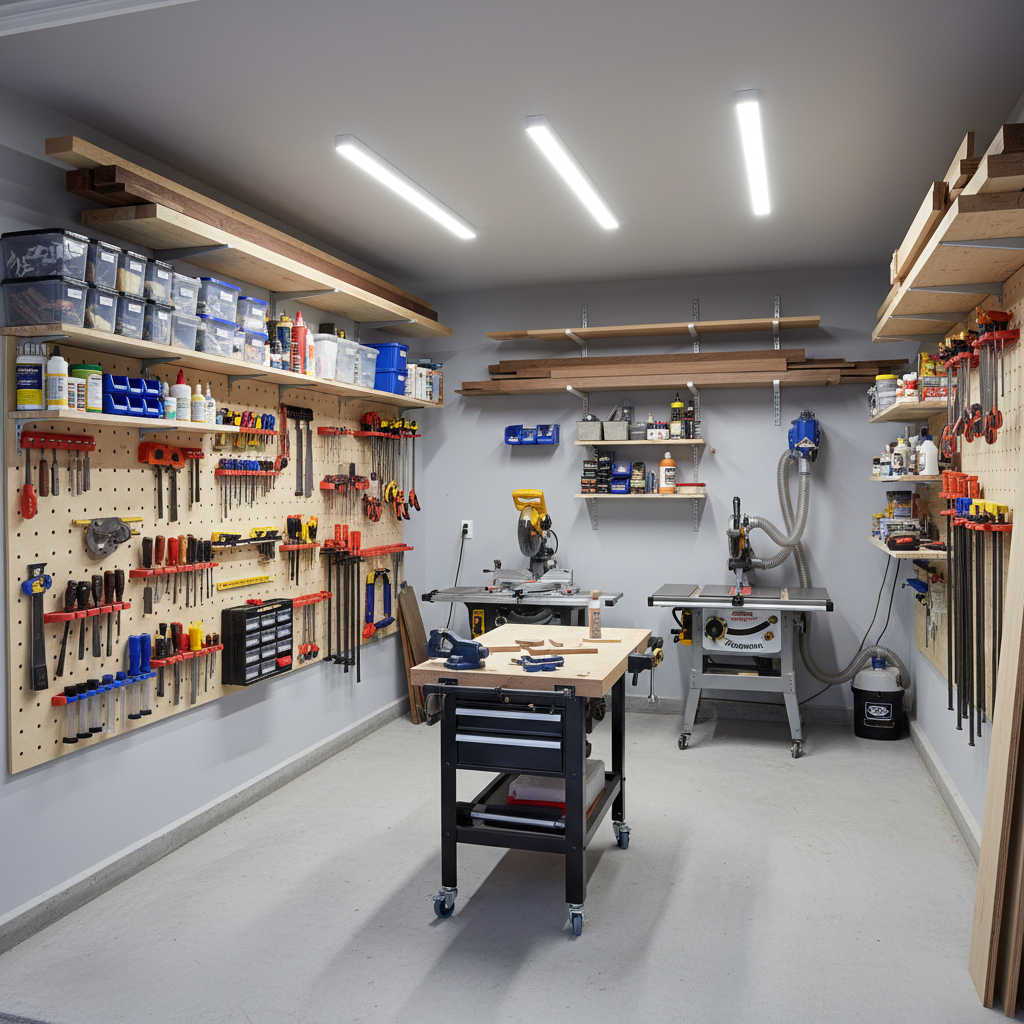Ever dreamt of having a dedicated woodworking shop, but all you’ve got is a cramped one-car garage, constantly battling for space with lawnmowers, bikes, and holiday decorations? Trust me, I’ve been there. For years, my woodworking ambitions felt suffocated by the limitations of my tiny garage. Every project started with a monumental effort just to *move* things around, let alone cut a piece of wood. But here’s the good news: you absolutely can create a functional, efficient, and even inspiring woodworking shop in a small garage. It’s not about having more space; it’s about making the most of every single square inch you do have.
I learned this through trial and error, a lot of head-scratching, and more than a few frustrated sighs. But eventually, I figured out a system that truly works for me, allowing me to tackle projects from small crafts to larger furniture pieces, all within my humble garage footprint. And today, I’m excited to share my journey and the practical strategies that helped me transform a cluttered storage unit into a productive woodworker’s haven. So, grab a coffee, and let’s talk about how you can do it too!
The Golden Rule: Measure Everything, Then Measure Again
Before you move a single tool or even buy a new piece of equipment, you need to understand your space intimately. This might sound obvious, but it’s astonishing how many of us just dive in. My first attempt at a “layout” was purely mental, and it was a disaster. I imagined where things would go, but forgot about things like walking paths, door swings, and the actual footprint of my table saw with its outfeed. Don’t be like past-me!
Here’s what I learned: Get a tape measure, a notepad, and a pencil (or a digital equivalent if you’re fancy). Measure every wall, every immovable object (like the water heater or electrical panel), and the dimensions of every major tool you own or plan to acquire. Draw a scaled floor plan of your garage. Then, draw scaled cutouts of your major tools. This is where the magic happens. You can physically (or digitally) move these tool cutouts around to see how they fit, how much space they need for operation, and what pathways remain. Think about:
- How much space does your table saw need for ripping a full sheet of plywood?
- Where will your miter saw go, and does it have enough support on either side?
- Do your garage doors still open and close easily?
- Is there clear access to electrical outlets?
This plaing phase is critical. It helps you visualize workflow and identify potential bottlenecks before they become real headaches.
Zoning Your Space: Think Like a City Plaer
Even in a small garage, it helps to delineate “zones” for different activities. This doesn’t mean building walls, but rather grouping similar tasks or tools together. My garage, for example, has these zones:
- Stock Storage: Where raw lumber and sheet goods are kept.
- Cutting Zone: Dominated by my table saw and miter saw.
- Assembly Zone: My main workbench usually doubles for this.
- Finishing Zone: Often just a corner with good ventilation, or even outside if weather permits.
- Tool Storage: All my hand tools, power drills, sanders, and accessories.
The trick in a small space is that these zones often overlap or are temporary. For instance, my cutting zone might become my assembly zone after I move the table saw out of the way. The key is to have a clear idea of where each activity can take place and what tools are associated with it. This plaing helps with efficiency and prevents constantly searching for tools or having to completely reconfigure your shop for every step of a project.
Mobility is Your Best Friend: Casters on EVERYTHING
If there’s one piece of advice I can give you for a small shop, it’s this: put casters on every tool you possibly can. Seriously, *everything*. My table saw, planer, jointer, dust collector, and even my main workbench are all on heavy-duty locking casters. This is an absolute game-changer. It transforms my fixed tools into flexible components of my shop, allowing me to:
- Move a tool out to the center of the garage for large cuts, then push it against a wall wheot in use.
- Reconfigure my entire shop layout in minutes to optimize for a specific task (e.g., long rips vs. cross-cuts).
- Easily clean dust and sawdust from underneath tools.
I started with just my table saw on casters, and the immediate improvement convinced me to do the same for all my stationary tools. Just make sure you get good quality, locking casters. You don’t want your tools rolling away mid-cut!
Vertical Storage: Look Up!
When floor space is precious, the only direction you can go is up. Vertical storage is your secret weapon. Think about all the wall space you have. My garage walls are now practically working overtime, holding everything from hand tools to lumber.
- Shelving Units: Simple, sturdy shelving can hold bins of screws, glues, finishes, and smaller tools.
- French Cleat System: This was a revelation for me! A French cleat wall allows you to create custom holders for specific tools (drills, sanders, clamps) that can be easily rearranged. It’s incredibly versatile and keeps your most-used tools visible and accessible.
- Ceiling-Mounted Storage: Don’t forget the ceiling! I built a simple rack above my garage door opener to store longer pieces of lumber and plywood scraps that I don’t need immediate access to. Just be sure to check your ceiling joist locations and don’t overload it.
- Pegboards: While not as robust as a French cleat system, pegboards are fantastic for organizing smaller items, wrenches, and frequently used hand tools.
The goal here is to get as much off the floor as possible, freeing up valuable real estate for actual woodworking. Every time I find myself tripping over something, my first thought is, “How can I store this vertically?”
Multi-Purpose Tools & Workbenches: The Swiss Army Knife Approach
In a small shop, single-purpose tools are a luxury you often can’t afford. Look for tools that can do double or even triple duty. My main workbench, for example, is more than just a surface for assembly. It has built-in dog holes for clamping, storage underneath for frequently used items, and when my table saw is moved, it often serves as an outfeed table. I also considered a multi-function workbench design that could fold up or combine several tools, but ultimately went for a sturdy mobile option.
Consider:
- Table Saw Outfeed: Can your workbench or a dedicated mobile cart serve as an outfeed table for your table saw? This saves needing a separate, dedicated outfeed table.
- Miter Saw Station: Can your miter saw be integrated into a mobile cart that also provides storage and outfeed support?
- Portable Workbenches: For tasks that require a separate surface or need to be done outside, a folding portable workbench (like a Kreg Mobile Project Center or similar) can be invaluable.
Thinking creatively about how each piece of equipment can serve multiple functions is crucial for efficiency in a tight space.
Dust Collection: Crucial for Health & Sanity
Let’s be honest, woodworking is messy. And in a small, enclosed space like a garage, dust can quickly become a serious health hazard and an organizational nightmare. Effective dust collection isn’t a luxury; it’s a necessity. I started with a shop vac, but quickly realized its limitations. I upgraded to a dedicated dust collector on wheels.
Here are some small-shop dust collection tips:
- Mobile Dust Collector: A unit on wheels allows you to easily move it from one tool to another.
- Flexible Hoses & Quick Coects: Use flexible hoses and quick-coect fittings so you can easily attach your dust collector to your table saw, planer, jointer, etc.
- Ceiling-Mounted Air Filter: Even with good dust collection, fine dust will linger. An ambient air filter helps clean the air while you’re working.
- Good Old Broom & Shop Vac: Don’t underestimate the power of a good sweep and vacuum at the end of each session.
Keeping dust under control not only protects your lungs but also makes your small shop feel cleaner and more organized, which is a huge psychological boost!
Lighting & Power: Don’t Skimp
Good lighting is paramount for safety and accuracy. Working in shadows is a recipe for mistakes and injuries. I added several LED shop lights to my ceiling, ensuring even, bright illumination across my entire workspace. I also have a portable task light for close-up work or when I need to illuminate a specific area.
For power, map out your outlets. Are there enough? Are they strategically placed? I found myself constantly tripping over extension cords initially. My solution was to install a few extra outlets along the walls and invest in a heavy-duty, retractable extension cord reel mounted to the ceiling, which keeps cords off the floor wheot in use. This makes a surprisingly big difference in both safety and workflow.
Embrace the Clean-Up Habit
Finally, and perhaps most importantly for a small shop, is the habit of cleaning up as you go, and definitely at the end of each session. Clutter multiplies at an alarming rate in a small space. A small pile of sawdust, a few misplaced tools, and a couple of offcuts can quickly make your shop feel unusable.
My routine is simple:
- Put tools away immediately after use.
- Sweep up major sawdust after each cutting operation.
- At the end of the day, everything has a home. The floor is swept, surfaces are cleared.
This isn’t just about neatness; it’s about efficiency. When your shop is clean and organized, you spend less time searching for tools and more time actually woodworking. Plus, it makes stepping into your shop a much more inviting experience.
Your Small Garage, Your Big Workshop
Transforming a small garage into a functional woodworking shop is a journey, not a destination. It involves continuous optimization, creative problem-solving, and a willingness to adapt. But I can tell you from personal experience, the satisfaction of stepping into a well-organized, efficient space that you’ve designed yourself, even if it’s small, is incredibly rewarding. You don’t need a sprawling industrial unit to pursue your passion. With smart plaing, mobility, vertical thinking, and good habits, your small garage can truly become the workshop of your dreams. So, what are you waiting for? Start measuring, start plaing, and get ready to create!




